Analytical Methods - Lead Isotopes
Lead isotope analysis (LIA) are done at the Servicio de Geocronología y Geoquímica Isotópica – SGIker, at the University of the Basque Country (UPV/EHU), Spain.
Sample preparation is performed in ISO 5 laminar-flow hoods within an ISO Class 7 clean lab. Reagent-grade acids and ultrapure water (18.2 MWcm) are distilled three times at sub-boiling temperature in closed perfluoroalkoxy (PFA) vessels prior to their use.
1. Sample Preparation
1.1 Samples that do not require lead purification
- Lead ore (Galena: PbS)
- Metallic-lead artifacts (ingots, sling bullets, ...)
Galena contains more than 80 weight % of lead. That means that one milligram of galena contains more than 800,000 nanograms of lead. The mass spectrometer is a highly-sensitive measuring instrument; for routine isotope analyses we only need about 300 nanograms of lead, although accurate results can be obtained with 15-30 nanograms of lead. Therefore, we need only a tiny amount of galena for the analysis. We extract this by gently scratching a small ore rock with a pair of pliers or tweezers (Photo 1). Given the huge quantity of lead in galena, contamination from the materials employed in sample preparation (plastics, metallic tools) is negligible.
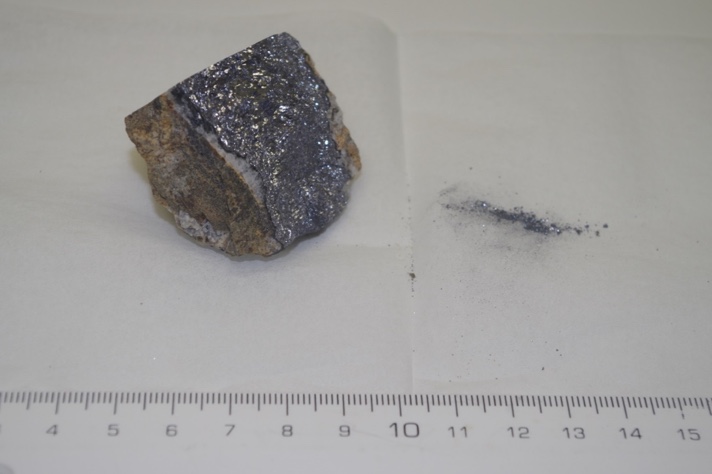
In the case of metallic-lead artifacts, we get an aliquot in a very similar way. These objects are metallic alloys with more than 90 weight % lead, and are soft and malleable. Instead of scratching, filing down the metal with a diamond tool works better.
The galena or metallic-lead powder is transferred to a polystyrene (PS) vial and cleaned in 300 microliters of HNO3 7 N for 10 minutes. After this surficial dissolution, the supernatant is removed with a disposable Pasteur pipette and discarded. Then a new volume of HNO3 7 N (200 microliters) is added to the cleaned galena for other 10 minutes. The new supernatant contains more than enough lead in the solution for analysis. This supernatant is transferred with a Pasteur pipette to a new PS vial and diluted in water to a final volume of 2 milliliters (Photo 2). By this process we get a stable solution with a fixed amount of lead.
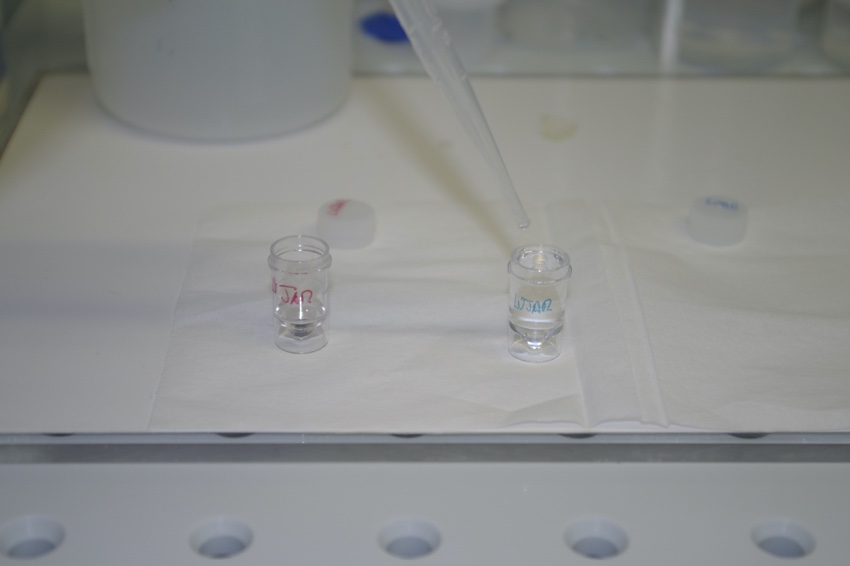
The new, stable solution still contains too much lead to be introduced into the mass spectrometer, so we perform a new dilution (1:1,500) in HNO3 0.32 N in a pre-cleaned PFA vial (Photo 3). This diluted acid guarantees that the analyte (lead) remains in solution and prevents the metallic parts of the spectrometer from quick degradation.
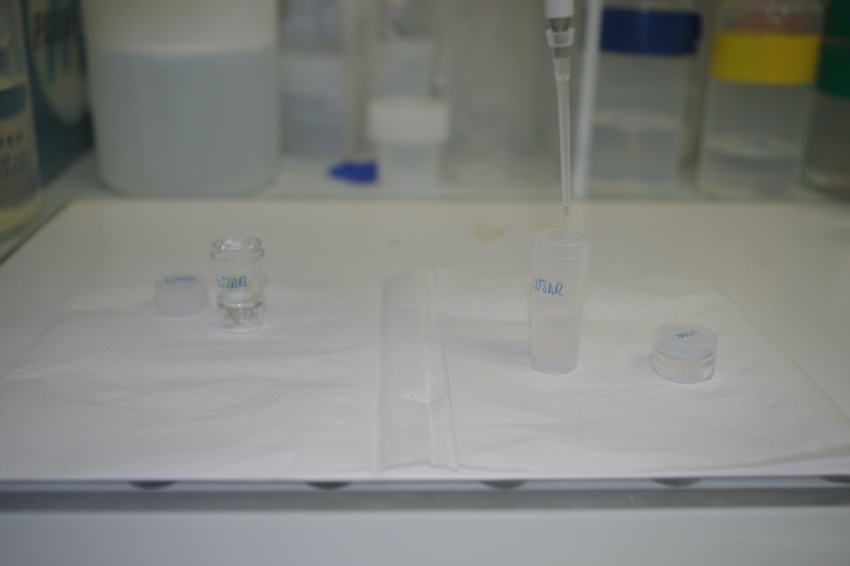
The final solution is now ready for mass spectrometry.
1.2 Samples that do require lead purification
- Other ores (copper, tin, gold, iron, ...)
- Metallic artifacts (bronze, gold, iron, ...)
Lead is present in almost every metallic ore and artifact as a trace element, normally in the range of a few nanograms of lead per milligram of ore/artifact. As a consequence, once we dissolve the ore or metal we get a complex mix of chemical elements that will affect the spectrometric measurement of lead. In order to get accurate results it is essential to purify the lead. In addition, it becomes critical to reduce the potential sources of contamination during sample handling.
Ore samples are crushed and grinded in an agate mortar. Metallic artifacts are filed down or micro-drilled with diamond tools. The powder aliquots are placed into pre-cleaned PFA vials and dissolved overnight in 0.5 - 2 milliliters of HNO3 7 N on a hotplate (70 º C). The following day the liquid is evaporated dry and the remaining salt is redissolved in 1 milliliter of HCl 1 N. This solution is percolated through a PFA chromatographic column filled with some milligrams of extraction material Sr-resin (Eichrom). The Sr-resin retains the lead and gets rid of the matrix elements. Lead is then recovered from the column (“back-extracted”) in HCl 6 N and collected in pre-cleaned, disposable PS vials. The HCl is dried down and the lead is redissolved in HNO3 0.32 N for mass spectrometry.
This lead purification protocol follows with minor modifications the method proposed by Gale (1996).
2. Mass Spectrometry
Our instrument is a Thermo ScientificTM NEPTUNETM Multicollector Inductively-Coupled Plasma Mass Spectrometer (MC-ICP-MS) (Photo 4).
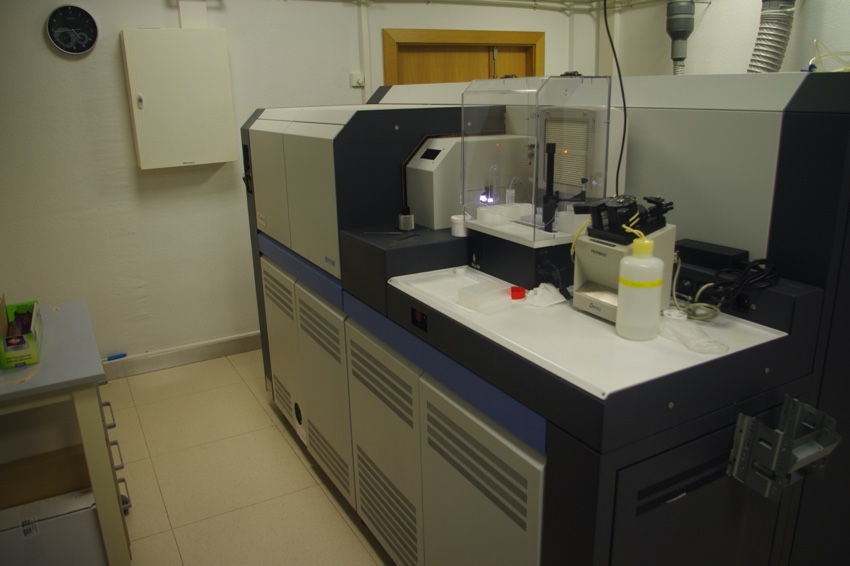
During an initial test, we estimated the concentration of Pb in the solution by comparing the intensity measured on it with the intensity measured on a known standard (Photo 5).
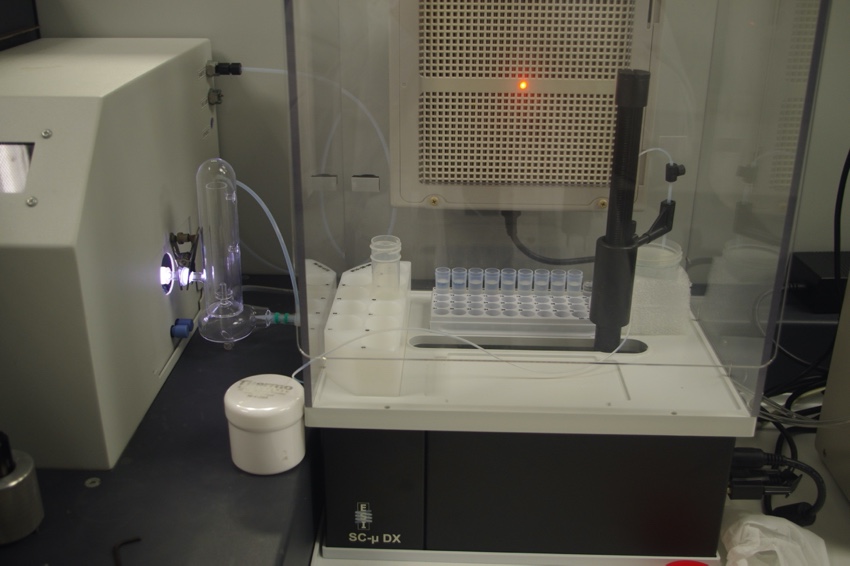
Once we know the actual concentration of lead in the solution, we adjust it to a final value of 200 nanograms of lead per gram of solution. The final step in preparation is the addition of a fixed amount of the thallium isotope certified material NBS-997 (Photo 6). Thallium, with isotopic masses very close to lead, serves to correct the intrinsic instrumental drift. The technical details of the spectrometric method are described in Rodríguez et al. (2020).
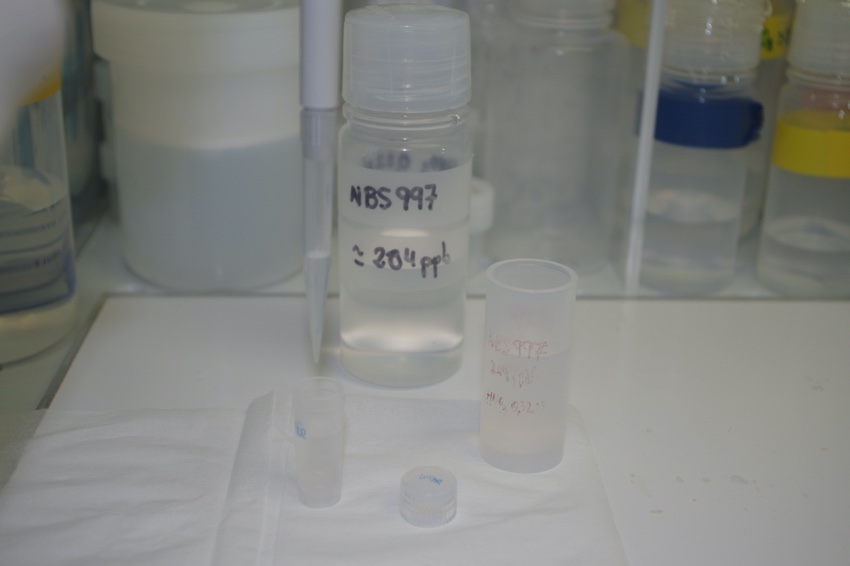
The sample is now ready for analysis. The data obtained from the spectrometer is the actual lead isotope ratios in the sample and can be compared with published analysis of lead ores and artifacts to study the provenance of the archaeological objects.
References
- Gale, N.H. (1996). A new method for extracting and purifying lead from difficult matrices for isotopic analysis.Analytica Chimica Acta 332, 15-21.https://doi.org/10.1016/0003-2670(96)00207-3
- Rodríguez, J. Montero-Ruiz, I., Hunt-Ortiz, M., García-Pavón, E. (2020). Cinnabar provenance of Chalcolithic red pigments in the Iberian Peninsula: a lead isotope study.Geoarchaeology 35, 871-882.https://doi.org/10.1002/gea.21810